| |
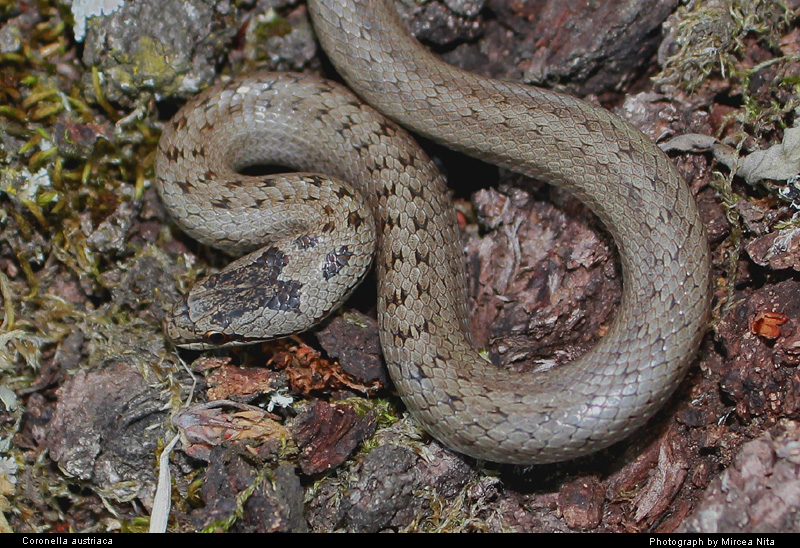
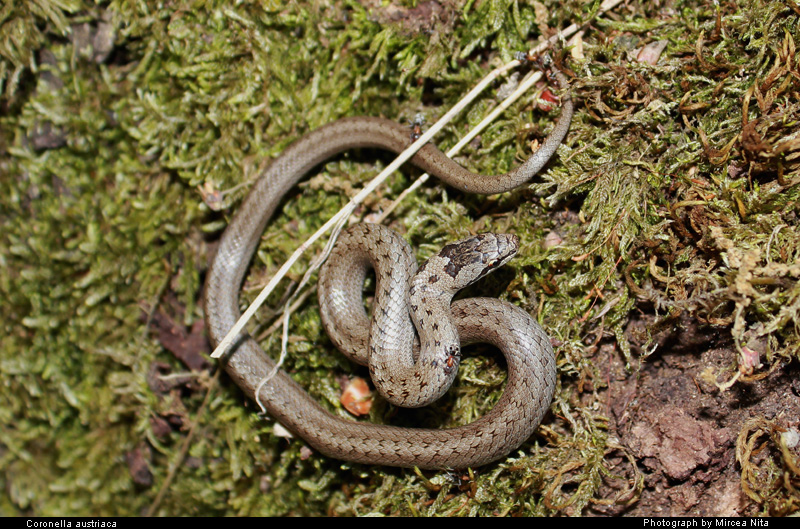
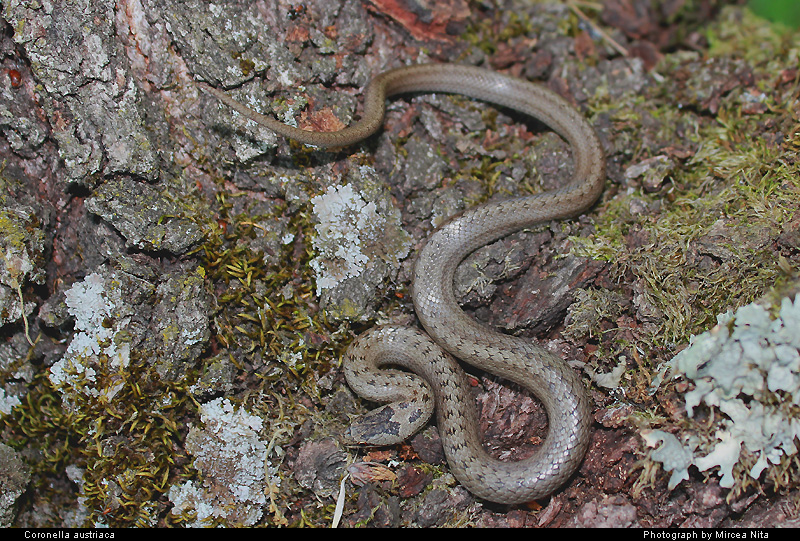
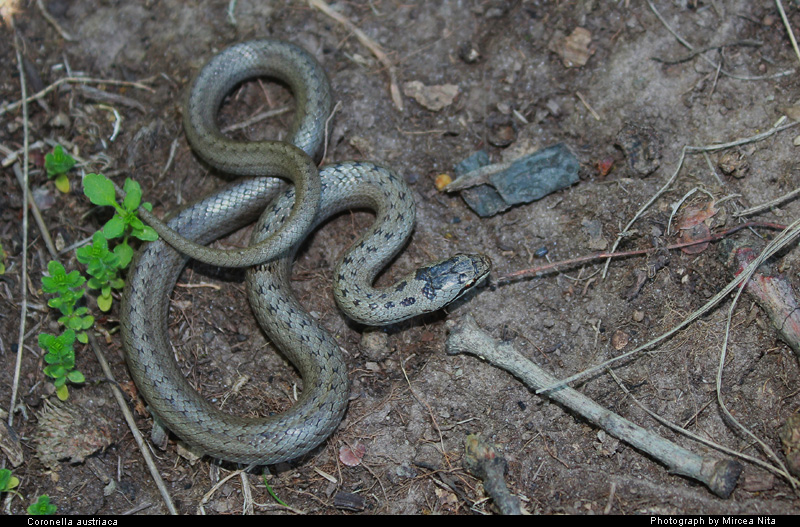
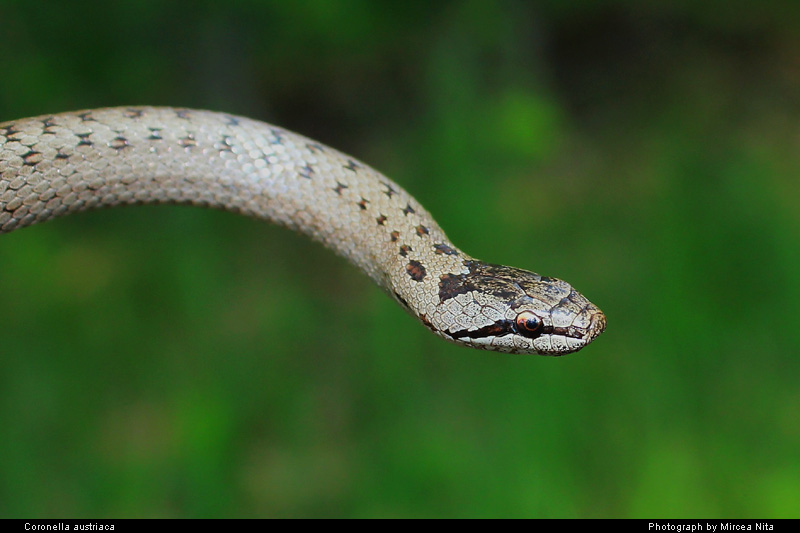
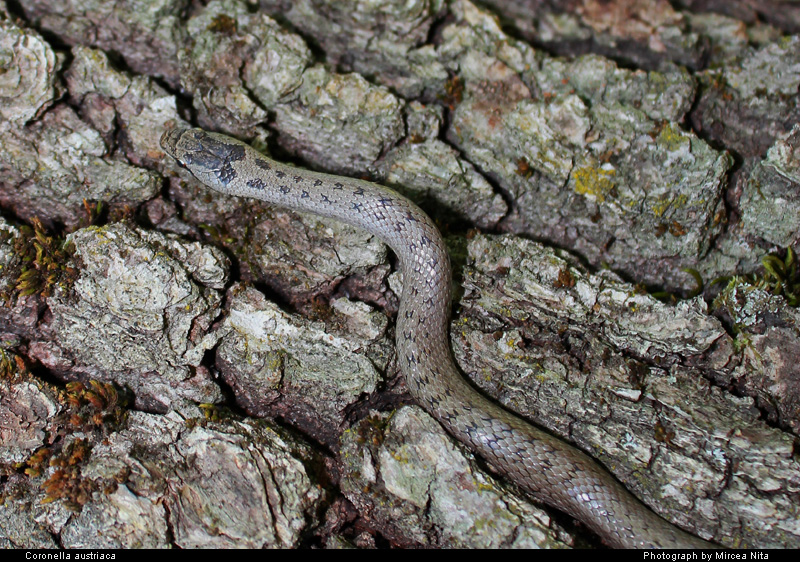
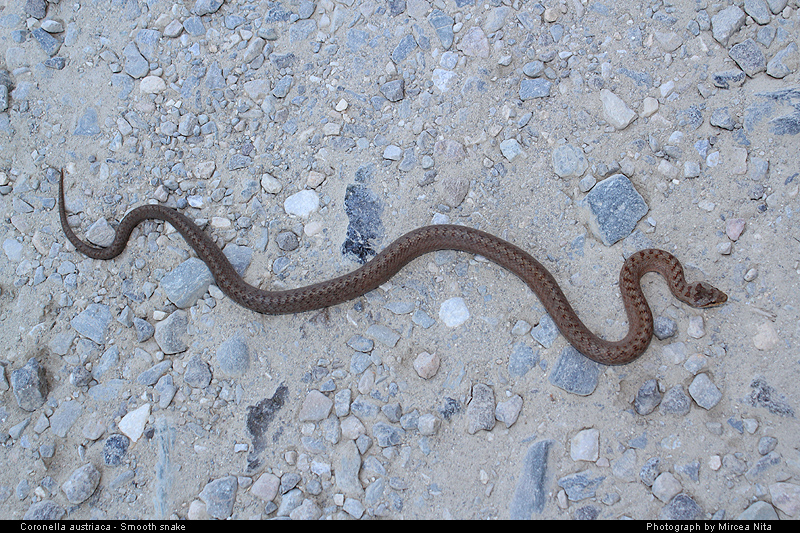
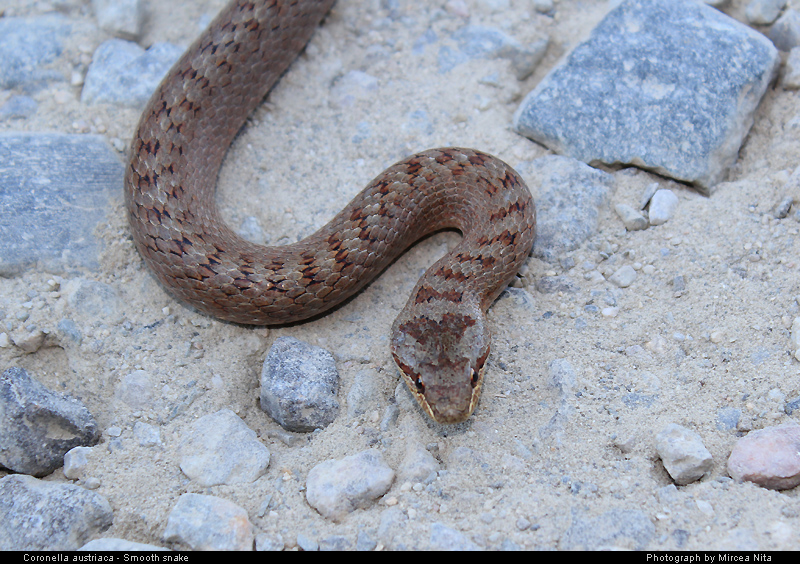
Smooth snake – Coronella austriaca – Laurenti, 1768
Description:
Coronella austriaca is a slender snake usually 50-60 cm in length, and growing up to 85-95 cm. Head is more or less flattened and slightly distinct from the body, with round pupil, the snout being more or less prominent. Maxillary teeth gradually increase towards backwards. Scales of the body are smooth with one or two apical pits. The tail is one-fourth (males) to one-sixth (females) of the total length.
Rostral at least as deep as broad; frontal is once and one-fourth to once and a half as long as broad, much broader than the supraocular, shorter than the parietals and widely separated from the preocular. The nasal is rarely undivided; loreal is longer than deep; one (very rarely two) preoculars and two postoculars; without suboculars; temporals 2 + 2 or 2 + 3 (very rarely 1 + 2). There are seven (rarely eight) upper labials, with the third and fourth (or fourth and fifth) bordering the eye; 19 (rarely 21) dorsal scales; less than 200 ventral plates. Subcaudal scales are arranged in two rows.
Smooth snakes are brown, greyish-brown (females), brown, reddish-brown (males) above, with small blackish, dark brown, or brick-red spots usually disposed in pairs running down the back towards the tail, each pair of spots sometimes forming cross-bars over the back and with a lighter series of dark spots running along each of the flanks. The top of the head has a heart-shaped marking that resembles an inverted V posteriorly; occasionally is nearly entirely blackish, especially in the young. A dark stripe on each side of the head extends from the nostril passing through the eye, sometimes extending along the side of the neck. Ventrally is brown, red-brick, orange (males), grayish to black (females), uniform or speckled or closely spotted with black and white. Specimens with a uniform grayish-brown coloration, without any markings, are very rare.
Biology:
The period of activity of this species lasts from end of March or beginning of April to September – October, but this may varies largely according to latitude and altitude.
Smooth snakes are ovoviviparous and breeding occurs soon after hibernation and it is has been suggested by some authors that the smooth snake may also mate in autumn. When conditions are unfavourable they may only produce young every second year.
The fully formed young, between two and nineteen in number, are born at the end of August – October. They measure from 14 to 16cm and the top of the head of juveniles is entirely black and the lateral series of spots on the body is more strongly marked. The young snakes may hibernate immediately after birth, emerging the following year in spring.
They reach sexual maturity when they are 3 to 4 years old.
Like other different species of snakes the females of Coronella austriaca are able to store sperm inside their body for a long period (between 90 and 475 days – Alexandru Strugariu: A case of efficient long term sperm storage in Smooth snake Coronella austriaca , Biota 8/1-2, 2007). Females store sperm in their reproductive tracts following copulation but before using it to fertilize their eggs. This sperm is used for reproduction when the species suffers from habitat fragmentation, excessive distances between populations or low energy reserves.
The smooth snakes are non-venomous and their food consists mostly of lizards, occasionally of slowworms or small snakes, more rarely of voles or mice, even shrews, which are captured and constricted in the coils of its body.
They are active by day but they avoid too much heat, retreating through the hottest parts of the day. This snake is extremely secretive, spending much of its time in a variety of crevices and holes in the ground, under stones, in loose sand and soil and concealed in litter and vegetation. When basking, they often wrap themselves around heather in order to camouflage themselves.
When caught, the smooth snake bites harmless or splashes a smelly secretion from the cloacal region. The average life span for Coronella austriaca is about 18 years. They are killed by birds of prey, other snake eating snakes, mammals...
Habitat:
The smooth snake prefers dry, sunny areas, and is found in rocky coastlines, open woodland and scrubland, hedgerows, woodland edges, heathland, sandy coastal sites, rock piles, screes, subalpine and open areas with sparse vegetation. In the south of its range (Greece, Iberian Peninsula) it is found in upland or mountain areas and they are also encountered in more moist habitat.
Distribution:
This species can be found from southern Scandinavia (Norway and Sweden where it is very rare and fragmented) and the Baltic region, through western, central and eastern Europe (excluding most of mainland Denmark, parts of southwestern France, and much of southern Iberia), into northern Turkey (much of Anatolia, with some isolated southern populations), the Caucasus region, northern Iran (Central Province) and Kazakhstan. It is also present in southern England (United Kingdom), on the Italian islands of Elba and Sicily (not in Corsica or Sardinia). In Finland, the species is found only on the Åland Islands but it is extremely rare.
It is found from sea level up to 2,750 m asl.
Scientific name: Coronella austriaca
The EMBL currently recognizes three subspecies, including the typical form described here:
- C. a. austriaca (Laurenti, 1768) is present over most of the species range except Portugal, northwestern Spain, England southern Italy and Sicily;
- C. a. fitzingeri (Bonaparte, 1840) inhabits the southern part of the Italian Peninsula and the island Sicily; they are much smaller then other subspecies and are more uniform in color;
- C. a. acutirostris (Malkus 1995) has been recently described and is found in Portugal and northwestern Spain; they have a much more pointed snout then other subspecies.
Common name: Smooth snake
IUCN Status: LC (Least Concern)
Listed as Least Concern in view of its wide distribution, presumed large population, and although it is declining in parts of its range, overall it is unlikely to be declining fast enough (30% or more) to qualify for listing in a more threatened category at the global level.
This species is listed on Annex II of the Bern Convention, and on Annex IV of the European Union Habitat and Species Directive.
The main factor responsible for the decline in numbers is believed to be the loss of heathland habitat, intensification of agricultural practices, fires in woodland or scrubland. Also the species is sometimes persecuted through confusion with vipers. It is protected by national legislation in parts of its range in most European states.
References:
Arnold, E. N., and J. A. Burton. 1978. A Field Guide to the Reptiles and Amphibians of Britain and Europe. Collins, London;
Boulenger, G.A. 1913, The Snakes of Europe;
Council of Europe. 2003. Convention on the Conservation of European Wildlife and Natural Habitats. Group of experts on the conservation of Amphibians and Reptiles. Mälmo (Sweden), 26-27 September 2003. Report T-PVS (2003) 18;
Covaciu-Marcov S.-D. et al. 2007. Contributions to the study of the geographical distribution of the herpetofauna in the North-East area of Arad County in Romania. Herpetologica Romanica 1: 62-69;
Covaciu-Marcov S.-D.; Ghira, I.; Cicort-Lucaciu A.-St., Sas I.; Strugariu, A. & Bogdan H. V. 2006. Contributions to knowledge regarding the geographical distribution of the herpetofauna of Dobrudja, Romania. North-Western Journal of Zoology 2 (2): 88-125;
Covaciu-Marcov, S.D., Cicort-Lucaciu, A.S., Dobre, F., Feren?i, S., Birceanu, M., Mihu?, R. & Str 2009. The herpetofauna of the Jiului Gorge National Park, Romania. North-Western Journal of Zoology 5 (Suppl. 1): 1-78;
Covaciu-Marcov, S.D., Cicort-Lucaciu, A.S., Sas, I.; Mosu, A.G.; Toth, B. 2008. Contributions to the knowledge of the composition and geographical distribution of the Western Maramures County Herpetofauna. Herpetologica Romanica 2: 27-36;
Fuhn, I. & S. Vancea, 1961: Fauna Republicii Române, 14. Reptilia (Testoase, Sopârle, Serpi). Bucuresti;
Gadow, H. 1909. Amphibia and Reptilia. MacMillan, London, 668 pp.;
Gasc, J.-P., A. Cabela, J. Crnobrnja-Isailovic, D. Dolmen, K. Grossenbacher, P. Haffner, J. Lescure, H. Martens, J.P. Martinez-Rica, H. Maurin, M.E. Oliveira, T.S. Sofianidou, M. Veith & A. Zuiderwijk (1997): Atlas of Amphibians and Reptiles in Europe. – Societas Europaea Herpetologica und Muséum National d’Historie Naturelle (IEGB/SPN), Paris;
IUCN 2011. IUCN Red List of Threatened Species. Version 2011.2. ;
Sos T., (2008): Review of recent taxonomic and nomenclatural changes in European Amphibia and Reptilia related to Romanian herpetofauna. Herpetologica Romanica, 2, 61-91;
Strugariu Al. (2007): A case of efficient long term sperm storage in smooth snake Coronella austriaca. Biota - Journal of Biology;
Szczerbak, N.N. 2003. Guide to the Reptiles of the Eastern Palearctic. Krieger, Malabar, FL, 260 pp.
|
|

